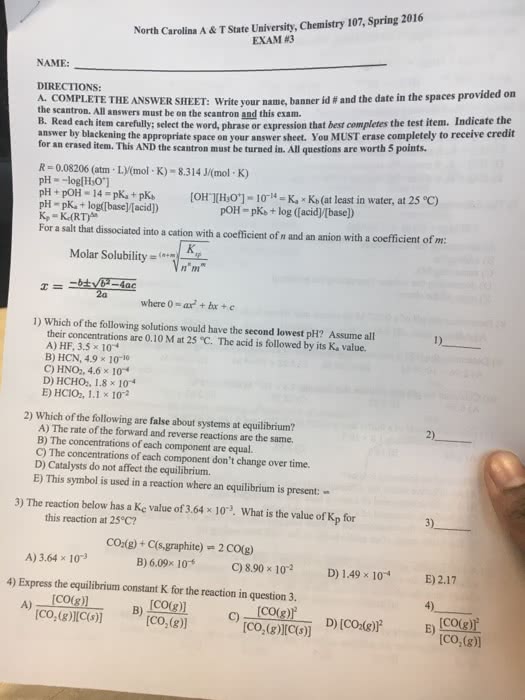HERE IS HOW THIS IS GOING TO WORK! IF YOU ANSWER THE QUESTIONS IWILL GIVE YOU THE 3K POINTS + MORE AFTER I REPOST IT.
2. The amount of heat involved in the synthesis of 1 mole of acompound from its elements, with all substances in their standardstates at 25*C, is called _________.
3. What is a valid unit for specific heat?
4. Use Hess's Law to find the heat of reaction in the examplebelow.
N2O4 (g) ----> 2NO2 (g)
Given that:
N2O4 (g) ----> N2 (g) + 2O2 (g) (Delta H =-9.7kJ)
2NO2 (g) ----> 2O2(g) + N2(g) ( Delta H= -67.7kJ)
5. Use Hess's Law to find the heat of reaction in the examplebelow. (Example doesn't exist btw.)
6. (Delta H) for the formation of rust (Fe2O3) is -826 kJ/mol. Howmuch energy is involved in the formation of 5 grams ofrust?
7. How many kilocalories of heat are required to raise thetemperature of 50g of aluminum from -5*C to 35*C? (Specific heat ofAluminum = 0.21 cal/g*C)
8.Calculate the (Delta H) for this reaction:
Zn(s) + Cu (2+ ion)(aq) ---> Zn(2+) + Cu(s)
(Delta H) for Cu(2+) = +64.4 kJ/Mol; (Delta H) for Zn(2+) = -152.4kJ/mol
9. The following equation shows the reaction that occurs whennitroglycerine explodes.
4C3H5O9N3 ----> 12CO2 + 6N2 + O2 +10H2O + 1725 Kcal
Is this reaction exothermic , endothermic, a combustion reaction ,or a combination reaction?
10. What does it mean for ammonia, (NH3) to have a (Delta H f) =-46 kJ/mol?
(for example: Define heat of formation. What does a negative heatof formation mean? what do the units of kJ/mol mean?)
11. What is the maximum amount of KCl that can dissolve in 500g ofwater?
(solubility of KCl is 34 g/ 100g of water at 20*C)
12.List the ways(operations) that can help make a substancedissolve faster in a solvent?
13. If a crystal added to an aqueous solution causes many particlesto come out of solution, the original solution was (saturate,unsaturated, supersaturated).
14. What is the number of moles of solute in 165 mL of a 0.82 Msolution?
15. What mass of NaCl is needed to make 350 mL of a 1.00 Msolution?
16. Colligative properties depend upon...
17. If one mole of each of these solutes in added to the sameamount of water, which solution has the highest boiling point?(glucose, aluminum sulfate, magnesium acetate, copper (I)chloride)
18. When an acid reacts with a base, what compounds areformed?
19. If the [H+] in a solution is 1x10^(-13) mol/L, what is the[OH-]?
20. If the [OH-] = 1x10^-6 mol/L, what is the pH of thesolution?
21. For a solution to be considered acidic what must be thehydrogen-ion concentration?
22. Which of the following represents a Bronsted-Lowry conjugateacid-base pair?
a) SO3(2-) and SO2 b) CO3(2-) and CO c) H3O and H2 d) NH4(+) and NH3
23. With solutions of "strong" acids and "strong" bases, the word"strong" refers to ...
24. What are the products of Al(OH)3 + H2CO3?
25.What is the concentration of hydrochloric acid if 5.0 mL of acidis neutralized by 30.0 mL of 2.00M sodium hydroxide.
26. At equilibrium, what is the rate of production of reactantscompared with the rate of production of products?
27. What is the equilibrium constant for the following reaction2SO3 ---> 2SO2 + O2
28. How does an increase in pressure affect the following reaction?2SO3 (g) --> 2SO2(g) +O2(g)
29.What stresses would shift the reaction to the right?
2SO3(g) ==> 2SO2(g) + O2(g)
30. The Keq of a reaction 4.9 x 10^(-7). Are products or reactantsfavored at equilibrium?
31. In which of these systems is the entropy decreasing?
a) air escaping from a tire b) snow melting c) a gas condensing d) salt dissolving inwater
32. If an atom is reduced in a redox reaction, what must occur toanother atom in the system?
33. Identify the oxidizing agent in the following reaction: 2Na + S---> Na2S
34. What are transferred in an oxidation -reductionreaction?
35. Give the oxidation number for each atom in KMnO4.
36. Which atom has a change in oxidation number of +4 in thefollowing reaction?
K2Cr2O7 + H2O + S ----> KOH + Cr2O3 +SO2
37. What is the oxidation number of sulfur in each of the following:
a. SO3 c.SO2(2-)
b. Na2SO4 d. S2O4 (2-)
38.Fe(3+) ----> Fe represents oxidation, reduction, orhydrolysis?
39. When the half reactions Br2+ 2e- -----> 2Br- and Na---->e- + Na(+) are combined the balanced redox equation is_____________________ ( WRITE the BALANCED REDOX eq)
40. To balance the oxygen and hydrogen for a redox reaction thattakes place in basic solution, it is necessary to use whichsubstance?
41. What particle completes this nuclear equation? 55/25 Mn + 2/1 H====> _____ +2 1/0 n
42. The half-life of tungsten-182 (182/74 W) is 1.1x10^(17) years.How long would it take for a 376.2 kg sample to decay until only123.0 grams remain?
43. After 3 days, the quantity of certain radioisotope is reducedfrom 13.6 grams to 1.9 grams. Calculate the half-life of theisotope.
44. What is the name of the compound having the formulaC8H18.
45. What is the name of the following compound:
O
//
CH3---CH2----CH---CH2--C
I \
CH3 OH
46. What is an isomer? Give an isomer of hexane (C6H14) and drawit's structure.
47. What is the name of the hydrocarbons with double covalentbonds?
48. Draw the stucture for 3-methylbutanoic acid.
49. Draw the structure for methylbenzene?
50. What is the name of the following compound:
Br
|
CH3----C-----CH3
|
CH3



